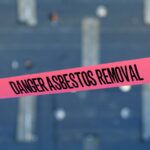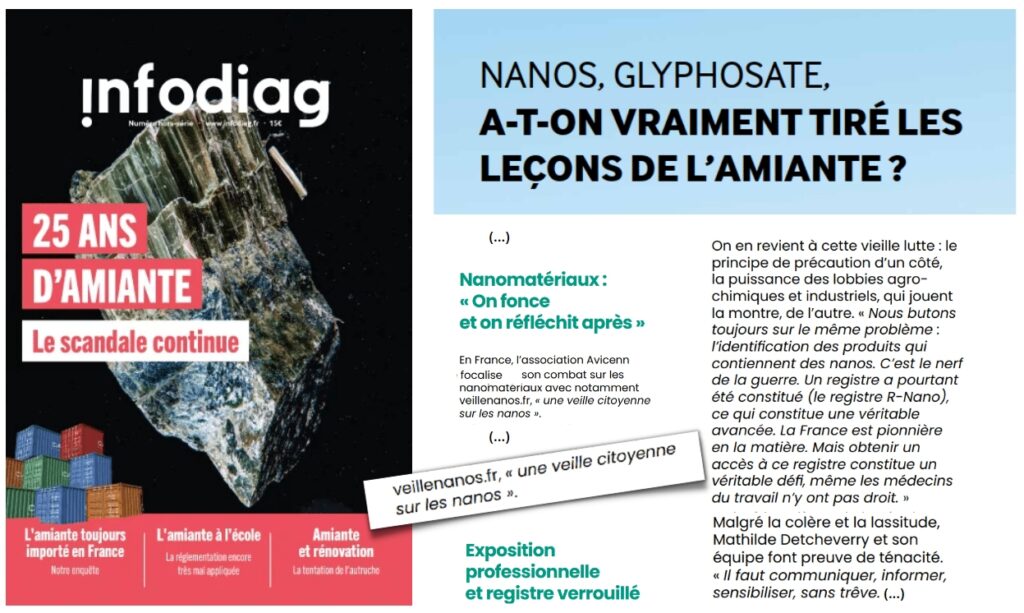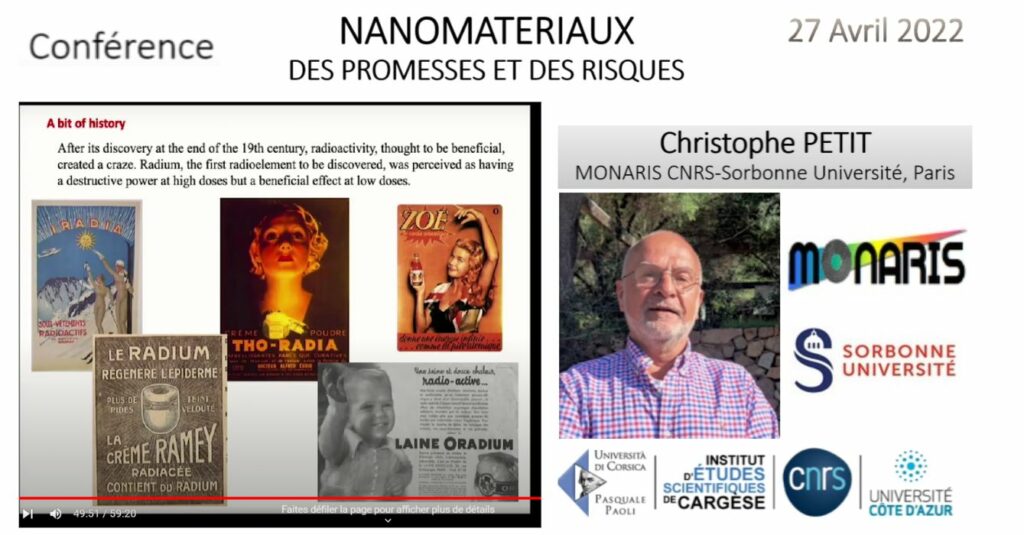
Nanos and risks: avoiding repeating past mistakes

Nanos and risks: Let’s not repeat the mistakes of the past
By the AVICENN team – Last modification September 2022
Faced with the uncertainties about the risks associated with nanomaterials, what attitude should we adopt? The same questions and debates between stakeholders occur as was the case for substances such as lead, mercury, asbestos, DDT, PCBs, plant protection products, parabens or bisphenol, and more recently the “neonicotinoid” insecticides, etc.
How many years will it take before adequate measures are implemented for risk assessment and management?
Are we going to let the development of mass uses of all nanomaterials take place without distinguishing potentially useful uses from the more futile ones and keep our fingers crossed that there will be no need to intervene afterwards? Or will we manage to learn from similar past experiences and act accordingly?
The body of knowledge is indeed evolving at a pace that institutional burdens cannot keep up with: the delays are still too long between obtaining results, their publication, and their consideration by risk assessment and management authorities, their communication to field actors, and finally the concrete implementation of appropriate measures. Once large quantities of nanomaterials are released into the environment and mixed with the few hundred thousand synthetic chemical substances already present, it will be too late to act effectively.
It is necessary to deploy a real research strategy. This strategy must be built around the concerns of civil society and the needs of companies and health and environmental authorities responsible for better assessing and/or managing these risks. The difficulty of evaluating, forecasting and managing risks remains enormous and calls for greater social and environmental responsibility on the part of all stakeholders (researchers, administrations, companies, elected officials, associations, media, etc.).
The monitoring and information work that we do on our website veillenanos.fr and social networks is intended to contribute to this.
Some quotes:
Mathilde Detcheverry, General Delegate of AVICENN, September 2022

Source: “Nanos, glyphosate, have we really learned the lessons of asbestos?”, 25 years of asbestos: the scandal continues, InfoDiag, Special Edition, September 2022
Christophe Petit, Sorbonne Université, April 2022

“After Marie Curie’s discovery of radium at the end of the 19th century, there was a craze for radium: radium underwear, radium beauty creams, Oradium wool, “supple, elastic, resistant, thick and comfortable, endowed by a physical-chemical treatment with a remarkable power: radioactivity. (…) Wool treated in this way combines the advantages of a textile with an undeniable hygienic value for knitting baby’s layette” (…) Fortunately, we no longer have layettes made from radioactive wool! (…) In 1937, radium was banned for all non-medical uses. (…) There’s always a gap between the discovery of an object, its appropriation by society and the hindsight we can gain from scientific studies on its long-term effects, which helps put its use into perspective. (…) Is it really necessary to put silver nanoparticles in underwear because it will smell better at the end of the day? Maybe it’s more efficient to wash them… because (…) the nanoparticles will get into the wash water and then end up in the rivers. So let’s also think about the uses of these materials. (…)
When you get new techniques, you get new uses: with what effects on living organisms, what impact on the environment and health, what traceability, what ethical problems for society? We need to continue these studies, with a citizen dialogue based on these scientific studies.”
Source : Nanomaterials : promises and risks – Christophe Petit (Professor at Sorbonne University, Head of MONARIS laboratory), April 2022
Dorota Napierska, head of the “Safer Chemicals program”, August 2020
“Historically, failure to consider the risks of seemingly beneficial chemical agents has led to large-scale exposures that have led to adverse human health and environmental effects discovered years or decades later, long after the damage was done. We have the opportunity to avoid repeating the same mistakes with nanosilver.”.
Source: Nanosilver in healthcare – does the silver bullet exist?, European Nanomaterials Observatory, August 2020
Annabelle Littoz-Monnet, professor of political science at IHEID, November 2018
“The aim (…) is to promote a balanced debate on the potential, but also the risks and uncertainties associated with these technologies, and to answer a key question: what decision should be made in the face of uncertainty? The current state of research on nanotechnologies does not allow us to determine whether these materials are safe”.
Source : Les nanotechnologies: regulating in a situation of uncertainty, Le Temps, 12 November 2018
Philippe Bihouix, La Fabrique Ecologique, October 2018
“A low-tech innovation? What is this strange oxymoron? Should we go back to candlelight or the cave age instead of relying on technological progress? Of course, low-tech does not make people dream like high-tech and its futuristic applications. And yet, what if this was where true modernity and the courage to innovate lay? (…) “Green” and intelligent technologies are presented as the key to solving the planetary challenge. On closer inspection, it would be dangerous to rest the ecological transition on ever more complex technological innovation: high-tech often tends to accelerate our “extractivist” model, to move us away from the circular economy and to provoke numerous social, human and political problems. If all high-tech is not the Eldorado promised by some, it is essential to think differently and to develop, in parallel, the concept and the so-called “low-tech” initiatives.”
Source: Pour une société durable, sobre et résiliente… Osons le low-tech !, interview with Philippe Bihouix, Actu environnement, October 2018 and note Vers des technologies sobres et résilientes – Pourquoi et comment développer l’innovation low-tech ?, La Fabrique Ecologique, October 2018.
United Nations Environment Programme (UNEP), December 2017:
“From our experience with asbestos and other hazardous materials, we know that the list of potential hazards is long. Environmental exposure to manufactured nanomaterials is inevitable.
Their adverse effects and persistence could have significant consequences for organisms, ecosystems and food chains. (…) Industrial development proceeds much faster than the implementation of regulations. In the absence of long-term monitoring and due to the lack of scientific data on the many aspects related to the toxicology and toxicity of nanomaterials, the adoption of specific regulations is slow, although there is increasing evidence that nanomaterials are dangerous and that there are risks related to their exposure. (…) It is necessary to adopt not only transformative policies to encourage innovation and industrial applications of green chemistry, but above all appropriate and iterative regulatory frameworks that apply the precautionary principle to ensure safety and prevent pollution. The world cannot afford to exploit the promising opportunities offered by new materials without considering the lessons of the past regarding health and environmental risks and damages.”
Source : https://wedocs.unep.org/…
Corinne Lepage, The choice of the worst, from the planet to the ballot box, February 2017
“In fact, the real subject is not the precautionary principle, but responsibility, responsibility in the broadest sense of the term, that is to say, the fact of assuming the consequences of one’s choices. However, with new technologies, whether GMOs or nanotechnologies, at a certain threshold, dissemination makes it impossible to determine responsibility. The objective of industrialists is to drag things out until this threshold is reached. This stage seems to me to have been reached today. Nanotechnologies are widely used without any control. We live in a system in which the industrial world invents the rules of its irresponsibility. We have succeeded in emptying precaution of its content and turning it into a purely virtual principle by making people believe, the height of hypocrisy, that it is an obstacle to development.
Source : https://www.puf.com/…
Vladimir Baulin, Nanotechnology is like the early days of radioactivity when it comes to knowing the risks, February 2, 2017
“It becomes urgent to understand the exact mechanisms of nanotoxicity and to make a classification according to the mechanism. Radioactivity or X-rays entered our lives in the same way. It took a long time before researchers understood the mechanisms of action on living organisms,” warned Vladimir Baulin of the Rovira i Virgili University in Tarragona, Spain.”
Dr. Baulin co-authored an article published last November in Science Advances which shows for the first time that nanoparticles can cross the biological membrane. The study stems from the SNAL project, funded by the European Union.
Source : https://horizon-magazine.eu/...
François Jarrige, They criticized progress, February 22, 2016
“We can already wonder what our world would be like if no one had ever questioned the benefits of technology; if no one had worked to remove from the market certain toxic products such as DDT, the insecticide used in agriculture and in the fight against malaria, or chlorofluorocarbons (CFCs), which are responsible for the hole in the ozone layer. Today, we are in a paradoxical situation. In many ways, a new techno-critical phase has begun. With the financial and economic crisis, the depletion of natural resources, the increasingly visible degradation of the environment… but also with the rise of social inequalities, many feel the need to rethink the technical project of modernity, its gigantism and its relentless acceleration. The history of techno-criticism puts certain very contemporary debates into perspective. For the first time, we dare to tackle the question of the power acquired by man, capable of modifying the great balances of the globe, of extinguishing or modifying animal species, of artificializing life… However, it remains difficult to contest technological consumerism and the fascination for the latest gadgets supposed to boost growth and solve our problems. And the debate is still caricatured between those who swear by technical innovation and those who already see the apocalypse coming…”
Source : https://lejournal.cnrs.fr/…
Sébastien Delpont, “Let’s get out of the innovation controversies,” Sept. 22, 2014
“Whatever the sincerity of the stakeholders involved, they have to realize that in France there is such a legacy on these issues (asbestos, contaminated blood, chlordecone) that it is not tomorrow that we will switch, in the eyes of the population, from the presumption of guilt to the presumption of innocence when a controversy emerges. (…) The time when it was possible to impose a technology on a society convinced of the correctness of its central state’s analysis (as for nuclear power) is over. Our interconnected world has made it possible to break down the asymmetry of information on access to scientific research. Data on these controversies are accessible in a few clicks on dedicated sites or social networks. (…) The final consumer, who is the most concerned, seems to be the one who has been forgotten in these fierce battles between industrialists and NGOs where conflicts of interest reign. He/she is taken as a witness during the battle of arms but without being given all the relevant information. He/she no longer knows where to turn and needs to rely on trusted intermediaries. (…) The only way out for manufacturers launching new technologies is to enter into voluntary and positive approaches to settle these controversies. These transparent approaches must include all stakeholders from the outset: manufacturers, distributors, associations, public authorities in the analysis of risks, the hunt for conflicts of interest and the explanation to the general public.”
Source : www.lemonde.fr/…
David Suzuki, Speculation, eyes closed and nasty surprises, Aug. 12, 2014
“Nanomaterials may well turn out to be a boon to humans, but we don’t know enough about their long-term effects to be adding them so indiscriminately to our food systems and other products. If we’ve learned anything from past experience, it’s that although we can speculate about the benefits of new technologies, reality doesn’t always match speculation, and a lack of knowledge can lead to nasty surprises down the road.”
Source : http://www.straight.com/…
Philippe Bihouix, author of L’âge des Low Tech, July 2014
“The more high-tech we are, the less recyclable things we make are and the more we use scarce resources that we will eventually run out of. It is absurd to believe that technological solutions can be deployed on the right scale. For example, all the agricultural residues on the planet would not be enough to cover our consumption of plastics alone. We must therefore turn to low technology. First, we must think about our needs. Before learning to do without cars, we need to limit the power of engines and lighten the weight. Design simpler objects, favor mono-materials, reduce electronic content (the Italian coffee maker versus the espresso machine) and set up a network for the recovery, repair, resale and sharing of everyday objects, tools, toys, household appliances. On this Earth, everything has an impact. There will never be a “clean” car, even if its energy would be “zero emissions”. It is therefore in temperance that we must seek salvation…”
Source : http://biosphere.blog.lemonde.fr/…
Steffen Foss Hansen and David Gee, Adequate and forward-looking research on the potential dangers of new technologies: a case of myopia and inertia?”, June 2014
“History confirms that despite the many benefits brought by technological innovations, they can also cause much human suffering, environmental degradation and economic costs. Are we not making history stutter with chemicals and new technologies? (…) In light of the history of past technological risks, where health and environmental research has been conducted too little and too late, we suggest that it would be prudent to devote between 5 and 15% of research and development to health and environmental research in order to anticipate and reduce potential risks while maximizing the commercial life of emerging technologies.”
Source : http://jech.bmj.com/…
William Dab, What risk mapping?”, June 15, 2014
“Uncertain risks deserve an organized public debate and politicians on the front line. If they concern large populations, they are a priority for research (e.g. nanotechnologies). Emerging risks call for specific vigilance procedures, dedicated research programs and educational actions.”
Source : http://securitesanitaire.blog.lemonde.fr/…
Roger Lenglet, Nanotoxics, March 2014
“Certainly the files on carcinogenic colorants and room fragrances, hormone-treated calves, bisphenol A, not to mention “mad cow”, aluminium salts and mercury in vaccines and fillings, for example, have left their mark on people’s memories. But many people are so made that they imagine that the same mistakes will not be made again. Even more people want to maintain their confidence in the “safeguards”, thinking that this is a necessary belief to continue living happily. An immemorial saying expresses this, “If we were careful about everything, we wouldn’t live.” Modern society has engendered this feeling and continues to nurture it, making us delegate caution and attention to dangers to higher authorities.”
Source : www.actes-sud.fr/…
Emmanuel Fort – Nanoparticles and biomedical innovation: therapeutic advances, health risks?, December 13, 2013
“The pace of innovation is spectacular and the diagnostic and therapeutic advances considerable. But what about the harmful effects of nanoparticles on our health… and on the animal and plant world? Researchers are questioning the possible ecotoxicity of these materials, such as those increasingly used in cosmetics and bath products.
Today, researchers at the Langevin Institute are urging caution about the proliferation of nanoparticle-based cosmetic products – particularly those containing silver. The gold nanoparticle would be harmless, especially if it is surrounded by a layer of silica, but here again contradictory studies have been published. Radium, discovered by Marie Curie and which slowly became fatal to her, also had its moment of glory and was used until the end of the 1930s in all sorts of everyday products, from toothpaste to fluorescent clock hands and sodas. Female workers would put it in their hair for its glittery effect, and an ear, nose and throat use for children even persisted in the United States until the 1970s.”
Source : www.paristechreview.com/…
Luc Perino – Good students of agnotology, November 27, 2013
“The danger of lead additives in gasoline was discovered in the 1930s and leaded gasoline was permanently banned in 2000. The carcinogenic role of asbestos was demonstrated in the 1930’s and it was not until the 1990’s that the first prohibition laws came into effect. The responsibility of tobacco in lung cancer was highlighted by the Doll and Hill study in 1950 but the first effective laws against tobacco appeared more than thirty years later. The harmful effects of excessive sugar consumption were evident at the beginning of the 20th century and the first alarms were triggered in the 1960s.
These examples, among the best known, show an incompressible delay of 30 to 60 years between the proof of a harmfulness and the first legislations intended to reduce it. The length of this delay is linked to the power of the lobbies and their expertise in “agnotology”. This neologism of Proctor designates the “science” of producing doubt and misunderstanding, its simple principle is based on a cascade of amalgams: since any study is always open to criticism, criticism becomes equivalent to an absence of proof, and the absence of proof is then assimilated to an absence of nuisance. The mainstream media are the natural amplifier of this, since their vitality comes from controversy and plurality of words.”.
Source: http://expertiseclinique.blog.lemonde.fr/…
Stéphane Foucart – Irrationality(s), November 15, 2013
“Science is thus lagging behind industry’s tremendous capacity for innovation. Knowing that regulation is itself structurally behind science, the trial of irrationality made to the opponents of “nanos” takes a rather paradoxical dimension. For if it is not reasonable to advocate the abandonment of research on these objects with such great promises, it does not seem very rational either to have generalized their use without having better explored the risks.
Disqualification on the grounds of irrationality is an old antiphon: in 1992, the famous Heidelberg Appeal (signed by hundreds of scientists) already castigated the “irrational prejudices” of environmental movements. The Heidelberg appeal already established the idea that any demand for a healthy environment, formulated outside the scientific establishment, was suspect of irrationality. We realized, but a little late, that the asbestos industry was behind the text.”
Source : https://lemonde.fr/...
Collectives of researchers – Scientific innovation: the citizens’ voice! October 29, 2013
“More than a century of scientific and technical development has shown us that if this development has allowed in some areas to improve the living conditions of humans and the environment, the opposite has unfortunately been widely manifested in many areas (biodiversity, climate, air and sea pollution, technological accidents…). The need for society to control these developments is now obvious.
Source : www.liberation.fr/…
William Dab – Nanotechnology, a case study, July 14, 2013
“When it comes to the risks of new technologies, nanotechnology is certainly a case in point. (…) Nanoparticles obviously raise health safety issues because their size allows them to cross biological barriers. The rapid development of this market will lead to increased human exposure. This is the only certainty we have, because for the rest, we face more questions than answers. Some toxicological studies show that they can induce pathological processes. At this point, it is a signal more than a proof. In reality, this is an area of maximum uncertainty and that’s what makes it a textbook case. It’s coming to market at such a pace that the risk assessment capabilities can’t keep up.”
Source : http://securitesanitaire.blog.lemonde.fr/…
European Environment Agency (EEA) – Early signals and late lessons, vol. 2, January 2013
“The first volume of Late Lessons from Early Warnings, published in 2001, was a groundbreaking report detailing the history of technologies that were later deemed dangerous. The 750-page Volume 2 published in January 2013 includes 20 new case studies including a case study on nanotechnology.
(…)
Historical case studies show that warnings were ignored or discounted until the health and environmental damage became unavoidable. In some cases, companies have prioritized short-term profits over public safety by hiding or ignoring the existence of potential risks. In other cases, scientists have downplayed the risks, sometimes under pressure from interest groups. These lessons could help us to avoid harmful consequences caused by new technologies. Five of these stories also illustrate the benefits of reacting quickly to early warning signs.
(…)
Favoring the precautionary principle is almost always beneficial – after analyzing 88 cases of so-called “false alarms”, the authors of the report validated only four. The report also shows that precautionary measures often stimulate rather than stifle innovation.”
Source : http://www.eea.europa.eu/…
Any questions or comments? This information sheet compiled by AVICENN is intended to be completed and updated. Please feel free to contribute.
Our information sheets to go further
Upcoming Nano Agenda

- Scientific conference
- 23rd International conference on Advanced Nanomaterials
- From July 23 to July 25, 2025
- Website: www.advanced-nanomaterials-conference.com

- E-learning program: awareness-raising for personnel who come into contact with nanomaterials during research, formulation, production, maintenance, cleaning, upkeep, etc., as well as safety coordinators or engineers, facility managers, heads of laboratories where nanoparticles are handled.
- Organizers: INSTN Grenoble (CEA)
- On the program:
- 1 – Introduction, definition and characteristics of nanomaterials
- 2 – Toxicity of nanomaterials: the state of knowledge
- 3 – Metrology and characterization of nanomaterials
- 4 – Prevention and protection against nanomaterials in the workplace
- 5 – Quiz: assessment of learning outcomes
- The 2-hour course can be viewed for one month from the date of registration.
- Website: https://instn.cea.fr/…risques-lies-aux-nanomateriaux…

- E-learning program: awareness-raising for personnel who come into contact with nanomaterials during research, formulation, production, maintenance, cleaning, upkeep, etc., as well as safety coordinators or engineers, facility managers, heads of laboratories where nanoparticles are handled.
- Organizers: INSTN Grenoble (CEA)
- On the program:
- 1 – Introduction, definition and characteristics of nanomaterials
- 2 – Toxicity of nanomaterials: the state of knowledge
- 3 – Metrology and characterization of nanomaterials
- 4 – Prevention and protection against nanomaterials in the workplace
- 5 – Quiz: assessment of learning outcomes
- The 2-hour course can be viewed for one month from the date of registration.
- Website: https://instn.cea.fr/…risques-lies-aux-nanomateriaux…
This sheet was originally created in November 2013






